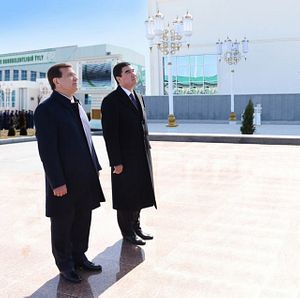Uzbekistan’s President Shavkat Mirziyoyev surprised many when he chose Turkmenistan as the destination for his first foreign visit after his election last December. But just days before Mirziyoyev would exchange smiles with his counterpart Gurbanguly Berdymukhamedov, Uzbek and Chinese officials shelved a project to expand the pipeline that pumps gas from Turkmenistan to China, a major setback for regional energy relations.
The so-called Line D expansion would not have followed the pipeline which already weaves through Uzbekistan and Kazakhstan before reaching western China. Instead, the plan was to route it through Uzbekistan, Tajikistan, and Kyrgyzstan, in an effort to diversify transit countries and potentially create new markets. But on March 2, China National Petroleum Corporation (CNPC) and Uzbekneftegaz, the state-owned companies in charge of the project, indefinitely postponed construction work.
The pipeline project had been delayed and modified several times over the past years, owing to disagreements between the Chinese funders and local companies. But the latest hiccup could impose unbearable pressure on Turkmenistan, which is eager to increase its exports to China.
China has become the principal recipient for Turkmen gas, especially after rows over pricing during the past couple of years have cut exports to Russia to zero. At a time of low oil prices and with pipeline alternatives – read: TAPI – far on the horizon, Turkmenistan hoped to rely on increased exports to China. While Beijing remains Turkmenistan’s most loyal customer, it imported less than projected last year, signaling that demand for Turkmen gas could plateau, or even drop, in the near future.
The interruption of construction works for Line D is a major blow to Turkmenistan’s hopes and could exacerbate the effects of the regional economic crisis that has hit Turkmenistan since early 2015. And while problems in Tajikistan and Kyrgyzstan were known, the announcement regarding the Uzbek section was the last straw for the pipeline.
Despite this, the diplomatic efforts of the new Uzbek leader have prompted analysts and financial institutions to hail the beginning of an era of openness and competition. The EBRD mulled it could return to the country after a decade, a move that could spur investments and financing opportunities. At a recent event, Kazakhstan’s minister of economy, Timur Suleimenov, said that “the liberalization in Uzbekistan will be a specific challenge for us, there will be a struggle for investments.”
Mirziyoyev could, effectively, put Uzbekistan back on the map as a regional hegemon, a status that it had progressively surrendered to Kazakhstan over the past decade, especially due to the international isolation that followed the repression of the revolts in Andijan in 2005. In a less optimistic view, however, this could just be a diplomatic façade to a regime that will continue on the authoritarian path paved by Mirziyoyev’s predecessor, Islam Karimov. After all, as a recent report from the International Crisis Group put it, “Mirziyoyev did not merely inherit a system of governance built on tight, often brutal control and suspicion of change. He had an important part in creating and implementing it.”
A tension remains between the international thrust for openness and the domestic political infighting and worsening economic conditions. With his first visit abroad, Mirziyoyev seems to have put more emphasis on the former, rather than the latter.
In the post-Soviet region, and especially in Central Asia, the first official visit after a presidential election is important. Many Central Asian leaders often choose Russia, as a token of friendship or to rekindle relations. Speculations on Mirziyoyev’s original choice of Russia and a later turn to Kazakhstan turned out incorrect. With his ultimate choice, Mirziyoyev appeared to seek a potential ally in Turkmenistan, which holds a long history of neutrality and isolation, both in the region and globally.
Behind the smiles and the handshakes that Mirziyoyev and Berdymukhamedov exchanged beneath a freshly-unveiled statue of late Karimov in Turkmenabat, there was the crude realization that closer relations are unlikely to solve the current economic malaise. The agreement on renewed economic cooperation that routinely follows these kinds of meetings looks even more fickle now that the Line D has become a pipe dream.
































